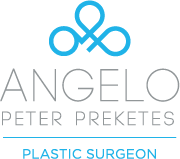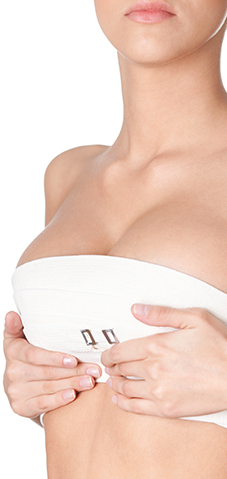Breast Surgery
Breast Augmentation
Augmentation Mammoplasty is an aesthetic (cosmetic) surgical procedure to increase the size of breasts. Augmentation Mammoplasty will also correct slight sagging of the breast and can increase breast firmness. A similar procedure can be used to recreate a breast after mastectomy.
If you feel your breasts are smaller than normal or out of proportion to your body size, a difference in cup size from right to left or if they have decreased in size following pregnancy augmentation surgery may be for you.
You should always keep in mind that the desired result is improvement, not perfection.
Augmentation surgery is performed by inserting a silicone gel implant either behind the breast tissue or behind the pectoral muscle. The implant is inserted through a small incision under the breast.
Following your procedure, there will be some swelling and bruising of the breasts for 2 to 3 weeks. Occasionally a capsule of scar tissue forms around the implant which makes the breast feel firm. In addition an implant may become fixed in a slightly high or low position. Although scars are the inevitable result of any surgery, Dr Preketes will make every effort to keep your scars as inconspicuous as possible. The scars are approximately 5cm centimetres long and are located in such a way that they become barely noticeable as they fade with time.
Emotional stability is the primary factor to be considered before any aesthetic surgery is performed. A “bigger bust” does not guarantee a new life or an end to all personal problems. It is mostly your mental attitude that determines a successful outcome. A breast augmentation can improve your appearance and renew your self-confidence; the rest is entirely up to you.
Breast implants may not last your entire life, second yearly check-ups are recommended following your formal discharge from Dr Preketes care post-operatively.
Breast Lift
Breast lift surgery is an option for women who are happy with the size of their breasts, but are unhappy about the sagging and loss of firmness. Dr Preketes recommends waiting until breast development, child birth and breast feeding have stopped before undertaking this surgery. This type of surgery can have unpredictable effects on breast shape.
All breast lift procedures leave permanent scars. These will be red initially and take up-to 12 months to fade. Sometimes the scars are unsatisfactory, therefore a scar revision may be required.
Breast Reduction
Reduction mammoplasty (breast reduction) is a surgical procedure aimed at reducing overly large or a sagging breast to a more comfortable shape and size.
You may suffer pain in the breasts, shoulders, lower neck or back, you may also have discomfort during physical activity. Breast reduction surgery minimises these problems, enhances the posture and helps improve your overall appearance and self-esteem.
A consultation with Dr Preketes is the first step in considering breast reduction surgery. You should discuss your goals and expectations. Dr Preketes will explain to you whether this procedure is right for you. Special examination techniques such as breast ultrasounds or mammograms may be required before the final decision. You should always keep in mind that the desired result is improvement, not perfection.
There are currently several techniques for breast reduction surgery. They all aim to remove excess breast tissue, re-contour the breasts, and reposition the nipples. Dr Preketes will take your physical condition and requirements into consideration, and will determine which technique would be best for you.
The scars are situated around the areolae of the nipple and under the breasts. They usually fade over 6 -12 months. Thus although scars will be present, most patients believe they are worth it. There may be an alteration in sensation of the nipples, but this often improves with time. Current techniques of breast reduction may preserve the ability to breast feed. However, you should discuss this with your surgeon. There is normally a difference in size between the breasts and this may persist following your procedure.
Breast Reconstruction
Reconstruction of the breast after a mastectomy operation is considered desirable by many women and most surgeons performing mastectomies will readily agree to refer you to a plastic surgeon for the procedure. If possible the best time to see a plastic surgeon is before the mastectomy. In some cases the reconstruction may be performed at the same operation, although this is only advisable when it is judged that the reconstruction will not interfere with any subsequent treatment of the breast cancer.
There are three primary ways of reconstructing the breast after mastectomy. All typically involve the provision of more skin, (since the mastectomy surgeon usually removes the large fold of skin covering the breast) and more bulk to produce the best shape and texture. Two of these methods require the use of implants. Reconstruction involving implants have a greater long-term complication rate, and do not look or feel as natural as your own tissue. For that reason, the third method of reconstruction, using the patient’s own natural fat and skin tissue has become the ‘gold standard’. However, this requires a longer period under anaesthetic, a longer hospital stay and can require a longer period away from work.
The Microsurgical “Tram Flap” Method
The TRAM flap can also be performed without microsurgery, using most of one of the abdominal muscles as a ‘pedicle’ to bring blood into the flap. This muscle remains attached to the under-rib area, and the fat of the lower abdomen pivots as it is moved under the skin through a tunnel to the breast area. Because more muscle is used in the pedicle technique, abdominal weakness is potentially a greater problem than with microsurgery. The blood supply to the flap is also weaker, with a higher rate of flap failure. Blood supply can be enhanced by performing the operation as a two-stage technique with a surgical delay of one week to two weeks between operations.
It has to be emphasised that the result of the surgery depends on many factors, and not every patient will be able to achieve the same quality of reconstruction. This is something you need to discuss with Dr Preketes and you may choose to seek a second opinion.
Tissue Expansion
In some patients it is possible to place an empty silicone bag under the skin of the mastectomy area, usually also under the muscle of the chest wall, which has a small valve attached and concealed under the skin. This first operation usually takes less than an hour. The bag or expander is usually partly filled at the time of surgery with sterile saline solution, then gradually further expanded over the course of several weeks or months with a once or twice-weekly injection through the skin into the valve, to ‘pump up’ the expander.
The ‘Best’ Option
Choice of procedure will depend on many factors, including age, state of health, size and shape of the opposite breast, sufficiency of loose abdominal skin etc. Dr Preketes will discuss this with you and recommend the best option in your own case.




